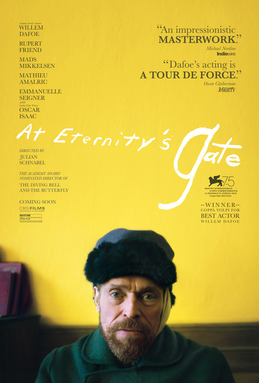
ARTIST TO ARTIST, SYMBOL TO SYMBOL
Posted December 23rd, 2018 at 9:22 pmNo Comments Yet
IN REVIEW
DAFOE PROVIDES A UNIQUE PORTRAIT OF FAMOUS DUTCH PAINTER VAN GOGH
By PETER THOMAS BUSCH
Dutch painter Vincent van Gogh sits for his portrait in an independent art house film that paints the desperate years of the unknown artist.
Willem Dafoe plays van Gogh during the most productive time he spent in Arles and Auver-sur-Oise, France painting still-life, portraits and landscapes that have become the most sought after paintings in modern times.
Dafoe shows how van Gogh is relatively unknown to his contemporaries in Paris but gradually becomes more and more emotionally consumed in his work as he inevitably finds the unique post-impressionist style that he is now famous for throughout the world.

Dafoe found success in Hollywood at the age of thirty playing leading roles in important films by the film industry’s great directors.
Oliver Stone cast Dafoe as the honest dutiful sergeant in the iconic film about the Unites States military involvement in Vietnam, in Platoon (1986). Dafoe’s character fatally stands out against the corruption within the soldier’s ranks.
Alan Parker cast Dafoe just two years later in the seminal civil rights film about the US Federal Bureau of Investigations’ search for a black youth and two missing civil rights workers in the deep south, in Mississippi Burning (1988). Dafoe plays the lead investigator bent on following the rules and regulations of the Bureau without success.
Martin Scorsese cast Dafoe in the same year as Jesus in the Last Temptation of Christ (1988).
Dafoe played several smaller supporting roles opposite leading actors such as Harrison Ford, Ralph Fiennes and Leonardo DiCaprio, while finding commercial success in the Sam Raimi Spider-Man Trilogy as the mad scientist consumed by his own technological military inventions.
Van Gogh is shown as a sympathetic character that may have fallen to the psychoactive effects of the popular drink made from green anise, absinthe.
Director Julian Schnabel experiments with film and camera techniques as well as the non-linear narrative to create a deeply subjective film that literally allows the audience to experience the world from the viewpoint of the Dutch painter.
Schnabel also films with realism by shooting on location where van Gogh lived in France and by using the same natural setting, including the biting wind and bitter cold, to paint van Gogh’s portrait with his camera.
The story of van Gogh has been put on film before, but Schnabel relies on the acting talents of his cast and his own ability to put aesthetics on film to create an entirely original treatment of the all too familiar tortured artist story.
Schnabel transfers his background in neo-expressionist art as a painter to the film by playing on perceptions with purposely disturbed treatment of the subjects being filmed.
Several scenes are filmed in natural light with a hand held camera to bump the audience out of their theater seats and into the leather boots of the protagonist as van Gogh marches through the landscapes he is about to paint into art history.
Tatiana Lisovkaia composes an original score that flows with the landscapes through many scenes absent any dialogue as the audience is invited to meditate with the artist as he explores the French countryside for the best light in which to paint.
Dafoe is joined in a series of acting vignettes throughout the film by supporting character actors Rupert Friend, Mads Mikkelsen and Oscar Isaac.
Isaac may be better known for his role as Poe Dameron, in Star Wars Episode VII: The Force Awakens (2015) and Star Wars Episode VIII: The Last Jedi (2017). Isaac has also had important character roles as the villain in Robin Hood (2010), Ex Machina (2014) and X-Men Apocalypse (2016).
In At Eternity’s Gate, Isaac plays famous post-impressionist painter, Paul Gaugin. Gaugin was a friend of van Gogh during their break through periods from obscurity to popular critical acclaim.
Isaac’s character acting adjusts slightly from film to film, playing the hot shot pilot opposite Daisy Ridley, then the cold calculating robotic engineer opposite Alicia Vikander, and then the careless arrogant king opposite Cate Blanchette.
Schnabel does well to bring in the talented cast and show their acting talents complementary to each other and to Dafoe.
Schnabel exhibits great overall vision for the film by manipulating the perceptions of the audience in a subjective manner to first bond with the painter and then empathize with him as he gradually discovers a unique method of painting subjects.
The film techniques are designed to create symbolic representations of the biopic material.
The narrative, however, is too linear and lacks surprises. The director instead relies on aesthetics and the ability of the audience to change perceptions on cue to compel the story line.